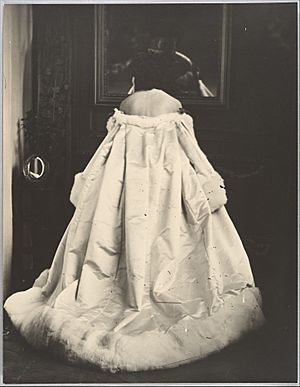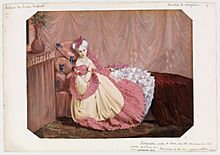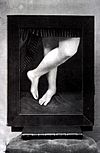Virginia Oldoini, Countess of Castiglione facts for kids
Quick facts for kids
Virginia Oldoini Rapallini
|
|
|---|---|

The Countess of Castiglione in a photo by Pierre-Louis Pierson, c. 1863/66
|
|
| Born |
Virginia Elisabetta Luisa Carlotta Antonietta Teresa Maria Oldoini Rapallini
22 March 1837 |
| Died | 28 November 1899 (aged 62) |
| Burial place | Père Lachaise Cemetery |
| Known for | Photographic artist and supposed secret agent |
| Title | Countess of Castiglione |
| Spouse(s) |
Francesco Verasis di Castiglione
(m. 1854; separated 1855) |
| Children | Giorgio Verasis di Castiglione (1855–1879) |
Virginia Oldoini Rapallini, also known as the Countess of Castiglione or La Castiglione, was an Italian noblewoman. Born on March 22, 1837, she became famous for her beauty and her connection to Emperor Napoleon III of France. She also played an important role in the early days of photography.
Contents
Early Life and Family
Virginia Elisabetta Luisa Carlotta Antonietta Teresa Maria Oldoini was born in Florence, Tuscany. Her parents were Marquis Filippo Oldoini Rapallini and Isabella Lamporecchi. She was often called "Nicchia" by her family. Her grandfather, Ranieri Lamporecchi, helped educate her.
At age 17, Virginia married Francesco Verasis, Count of Castiglione. He was twelve years older than her. They had one son named Giorgio.
A Special Mission in France
Virginia's cousin was Camillo Cavour, a powerful minister for Victor Emmanuel II, the King of Sardinia. In 1855, Virginia and her husband traveled to Paris. Her cousin asked her to help with an important goal: uniting Italy. She was asked to speak with Emperor Napoleon III of France about this.
During her time in Paris, she became known to Emperor Napoleon III. This connection caused her husband to separate from her. She also met many important people, including Augusta of Saxe-Weimar and Otto von Bismarck. The Countess was famous for her beauty and her amazing outfits at the royal court. She had long, wavy blonde hair and eyes that changed color.
Helping Italy Unite
The Countess returned to Italy in 1857. Four years later, the Kingdom of Italy was officially created. Many believe her influence on Napoleon III helped make this happen. She then moved back to France.
In 1871, after France lost a war, she met secretly with Otto von Bismarck. She convinced him that occupying Paris would not be good for his country. Because of her efforts, Paris was saved from being taken over by Prussian forces.
A Pioneer in Photography
Starting in 1856, the Countess began working with photographers Mayer and Pierson. They were popular with the royal family. Over the next forty years, she worked with Pierre-Louis Pierson to create about 700 unique photographs. In these photos, she acted out important moments from her life.
She spent a lot of her own money on this project. Many photos show her in special costumes, like her famous "Queen of Hearts" dress.

A poet and art collector named Robert de Montesquiou was very interested in the Countess. He wrote a book about her called La Divine Comtesse. After she died, he collected 433 of her photographs. These photos are now part of the Metropolitan Museum of Art collection.
Later Years and Legacy
In her later years, Virginia lived in an apartment in Place Vendôme in Paris. She decorated her rooms in black and kept the blinds closed. She also removed all mirrors. She would only leave her apartment at night.
She died on November 28, 1899, at the age of sixty-two. She was buried in the Père Lachaise Cemetery in Paris.
The Countess's life has been shown in films and books:
- A 1942 Italian film called The Countess of Castiglione.
- A 1954 Italian-French film called The Contessa's Secret, starring Yvonne De Carlo.
- The novel The Queen of the Night by Alexander Chee.
- The novel Exposition by Nathalie Léger.




